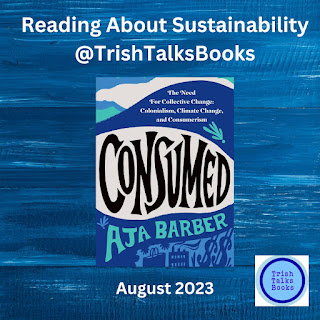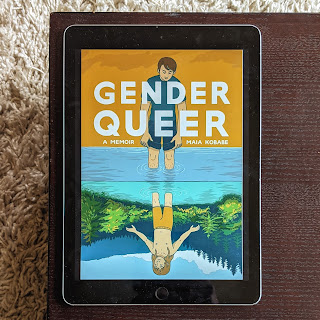Reading About Sustainability: Consumed by Aja Barber
Reading About Sustainability @trishtalksbooks
Consumed: The Need for Collective Change: Colonialism, Climate Change, and Consumerism by Aja Barber
Balance (2021)
You’re looking for an engaging introduction to the problems plaguing sustainability in the Fast Fashion industry, and the harms it carries globally I picked this book up because it was highlighted in Britt Wray’s excellent GenDread newsletter, which I subscribed to after I reviewed her excellent book Generation Dread in February. Consumed sparked my interest because I’m aware that textiles are a huge problem globally, but I didn’t know exactly why. You’re going to learn so much about how social inequity, race and colonialism have shaped the industry, and how it still does today.
About the Author:
Aja Barber is an American writer and educator who lives in London. She’s also been a fashion stylist involved in the industry for years, and decided to forgo fast fashion sponsorship for her social media endeavours. She writes at the intersection of fashion, sustainability and social justice. She brings ideas around “privilege, wealth inequality, racism, feminism, colonialism and how to fix the fashion industry with all these things in mind.” (ajabarber.com) After reading Consumed, I feel like she’s someone I know kind of well, which speaks to her candour and openness about herself and her life in the book (and her chatty style of writing!).
Why I wanted to read it:
I grew as a teen shopper in the 1980s, and boy did I love it. I did a combo of thrift shopping and mall shopping. My mom instilled in me the love of a good bargain (Thanks mom!). We’d go to the local Goodwill and find the perfect thrifted fashion piece, or go to the mall to shop the sale racks (The Bay was one of the best places to get lost in endless racks of discount clothes). This training made me a frugal clothes shopper, but an avid one. As I got older, it was Mariposa and Cotton Ginny (remember those?). And I worked at Smart Set! I’m clearly revealing myself for the decades old Canadian that I am. But I’ve been more of a thrift shopper for years and try to be mindful. I’ve heard so much about fashion’s effect on the environment and wanted to learn more.
Questions it answered for me:
I thought I knew enough about the environmental aspects of the fashion industry, and maybe I did, in a very narrow sense. The move to poor quality, almost disposable pieces that aren’t meant to last? They get deposited into a thrifting-shipping out of the country-foreign landfill cycle that not only encourages our enormous consumption of this clothing, but also engages us in mindless collusion with its disposal. Out of sight, as they say. But Barber’s book dragged this consumer chain into the bright light of day, not just reviewing the basic ecological problems, but showcasing the human cost. This, I think, is the true brilliance of the book.
There’s lots here that’s worth reading more about, but here are some key points that resonated with me:
Here’s Barber’s website:
https://www.ajabarber.com/
And here’s the interview that got me started, from Gen Dread: https://gendread.substack.com/p/how-our-cheap-clothing-perpetuates
The best resource list is the “How I Have Educated Myself” appendix in the book…but you’ll have to get the book for that one.
Consumed: The Need for Collective Change: Colonialism, Climate Change, and Consumerism by Aja Barber
Balance (2021)
Read This Book If:“There’s a real disconnect happening with us and our clothes, and that’s perhaps because the person who makes our clothes lives far away in a country we haven’t visited or know relatively little about. The tricky cognitive dissonance between what you buy and the system you are supporting by putting your money there isn’t easily connected unless you put the time into joining up the dots that link you back to the person hand-sewing your jeans.”
You’re looking for an engaging introduction to the problems plaguing sustainability in the Fast Fashion industry, and the harms it carries globally I picked this book up because it was highlighted in Britt Wray’s excellent GenDread newsletter, which I subscribed to after I reviewed her excellent book Generation Dread in February. Consumed sparked my interest because I’m aware that textiles are a huge problem globally, but I didn’t know exactly why. You’re going to learn so much about how social inequity, race and colonialism have shaped the industry, and how it still does today.
About the Author:
Aja Barber is an American writer and educator who lives in London. She’s also been a fashion stylist involved in the industry for years, and decided to forgo fast fashion sponsorship for her social media endeavours. She writes at the intersection of fashion, sustainability and social justice. She brings ideas around “privilege, wealth inequality, racism, feminism, colonialism and how to fix the fashion industry with all these things in mind.” (ajabarber.com) After reading Consumed, I feel like she’s someone I know kind of well, which speaks to her candour and openness about herself and her life in the book (and her chatty style of writing!).
Why I wanted to read it:
I grew as a teen shopper in the 1980s, and boy did I love it. I did a combo of thrift shopping and mall shopping. My mom instilled in me the love of a good bargain (Thanks mom!). We’d go to the local Goodwill and find the perfect thrifted fashion piece, or go to the mall to shop the sale racks (The Bay was one of the best places to get lost in endless racks of discount clothes). This training made me a frugal clothes shopper, but an avid one. As I got older, it was Mariposa and Cotton Ginny (remember those?). And I worked at Smart Set! I’m clearly revealing myself for the decades old Canadian that I am. But I’ve been more of a thrift shopper for years and try to be mindful. I’ve heard so much about fashion’s effect on the environment and wanted to learn more.
Questions it answered for me:
I thought I knew enough about the environmental aspects of the fashion industry, and maybe I did, in a very narrow sense. The move to poor quality, almost disposable pieces that aren’t meant to last? They get deposited into a thrifting-shipping out of the country-foreign landfill cycle that not only encourages our enormous consumption of this clothing, but also engages us in mindless collusion with its disposal. Out of sight, as they say. But Barber’s book dragged this consumer chain into the bright light of day, not just reviewing the basic ecological problems, but showcasing the human cost. This, I think, is the true brilliance of the book.
There’s lots here that’s worth reading more about, but here are some key points that resonated with me:
- She gets real about the collusion of colonization and fast fashion. Rich corporations extract labour, materials and waste textiles from poorer countries like Ghana (where we’ve shipped the clothing we don’t want anymore), who are left with little. This system needs to address decolonization and wealth redistribution–pay the poorest workers better, and share the profits. We can’t just continue to extract!
- She discusses the cycle that traps low wage garment workers in poverty, showing the HUGE gap between the garment worker and the multinational corporation.
- The scale of the industry is enormous. Barber gives ideas of how to scale down: fewer “seasons,” and better quality clothing. We consumers should buy less clothing and the big companies should make less and pay workers more. Did you know that some brands burn their excess clothing? “True sustainability requires less,” she notes.
- She examines the intersectionality of fast fashion and BIPOC women; cultural appropriation; and the “great con” of shopping, with its planned obsolescence, and manufactured need. She takes on greenwashing, “wokewashing” and factory outlet stores.
- Getting committed: this was so motivating. She talks about writing letters to companies and even gives a template.
- Taking ourselves to account: recognizing how fast fashion depends on fossil fuels, and working towards self-awareness in our own complicity with unmindful consumption.
- Working towards collective change: examine where to put your money and making responsible fashion choices.
- Breaking habits when it comes to fashion: so many useful tips, like wearing your clothes out before discarding and (gasp!) mending them.
“So, I need you to make a promise to yourself right now, that once we have worked through all of this, you’re not going to be silent about the broken systems anymore. Use that voice you have.”Further Resources:
Here’s Barber’s website:
https://www.ajabarber.com/
And here’s the interview that got me started, from Gen Dread: https://gendread.substack.com/p/how-our-cheap-clothing-perpetuates
The best resource list is the “How I Have Educated Myself” appendix in the book…but you’ll have to get the book for that one.



Comments
Post a Comment